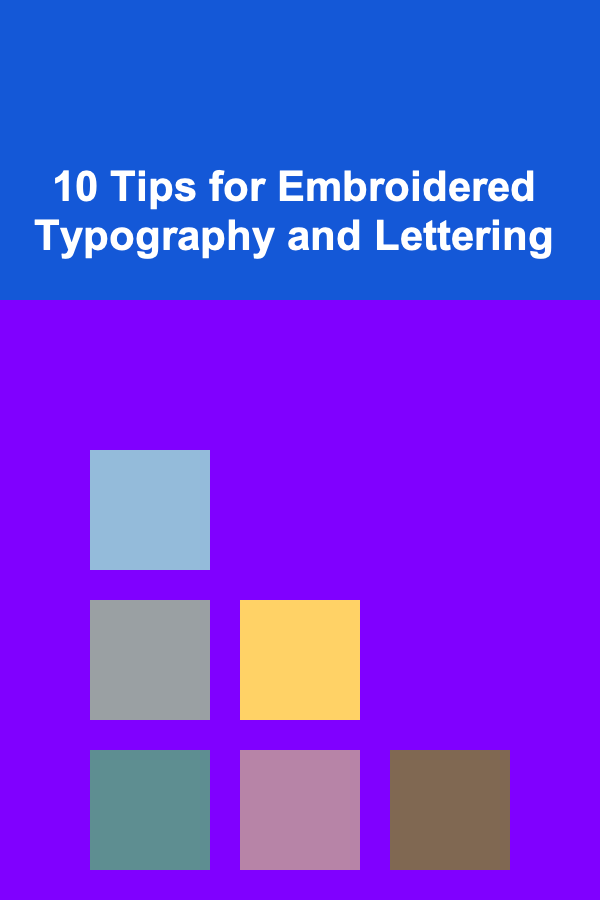
10 Tips for Embroidered Typography and Lettering
ebook include PDF & Audio bundle (Micro Guide)
$12.99$10.99
Limited Time Offer! Order within the next:

Embroidered typography is a fascinating form of art that has been gaining popularity in recent years. It combines the elegance of fine embroidery with the charm of type, creating visually striking and personalized text designs. Whether you're a professional embroiderer or someone just starting to explore the craft, understanding the fundamentals of embroidered typography can elevate your creations and allow you to experiment with different styles, materials, and techniques.
In this article, we'll share 10 essential tips for creating beautiful embroidered typography and lettering. From choosing the right materials to mastering various stitch techniques, these tips will help you create intricate, well-crafted text designs that stand out.
Choose the Right Font for Embroidery
The first step in creating embroidered typography is selecting the right font. Not all fonts are suitable for embroidery, as some designs may not translate well onto fabric. It's important to choose a font that is both visually appealing and practical for stitching.
a. Simple and Bold Fonts
When choosing a font for embroidery, opt for simple, bold, and easily readable typefaces. Fonts with thick, clean lines are ideal, as they will hold their shape and legibility when stitched. Sans-serif fonts tend to work better than serif fonts, as their clean edges are easier to reproduce with thread.
b. Consider the Fabric
The fabric you're working with also plays a significant role in font choice. A heavily detailed or intricate font may be difficult to stitch on fabric with a loose weave, such as linen. For fabrics with a tighter weave, you have more freedom to experiment with fonts that have finer details.
c. Size Matters
The size of your lettering will affect the ease and effectiveness of your embroidery. Larger fonts can accommodate more details, but smaller fonts may become blurry or difficult to read when stitched. Choose a font size that balances readability with the complexity of the design.
Use High-Quality Threads
The quality of your thread can greatly impact the final result of your embroidered typography. Choosing the right type of thread is crucial for achieving a clean and professional look.
a. Thread Types
For typography, cotton embroidery floss is a popular choice due to its smooth texture and vibrant color. You can also experiment with metallic threads for a bit of shine or use silk threads for a luxurious finish. When working on projects with intricate details, fine threads such as rayon or polyester may provide more precision.
b. Thread Thickness
Consider the thickness of the thread as it will affect the overall appearance of the embroidery. Thicker threads will create a more textured look, while thinner threads allow for delicate, detailed stitching. The thickness of the thread should complement the font size, fabric, and design.
c. Color Choices
The colors you choose for your embroidery threads are just as important as the font itself. Make sure the thread color contrasts well with the fabric to ensure legibility. Bright colors are great for making bold statements, while muted tones work well for subtle and elegant designs.
Test Your Design Before Embroidering
Before diving into the final piece, it's a good idea to test your typography design on a small swatch of fabric. This practice will help you determine how the font will look in thread, how the fabric reacts to stitching, and how the colors will appear when stitched.
a. Create a Sample Piece
Start by stitching a small sample of your typography design on a scrap piece of fabric. This will allow you to evaluate whether the font is legible, whether the thread thickness is appropriate, and if the stitch style works well with your design. Don't hesitate to make adjustments based on the results of the test piece.
b. Experiment with Different Stitches
Embroidery offers a variety of stitches, each providing a different texture and look. Try experimenting with different stitches, such as satin stitch, chain stitch, or backstitch, to see which best complements your typography design.
Master Basic Embroidery Stitches
Embroidery is all about mastering stitches, and a few basic stitches are particularly well-suited to typography. The following stitches are commonly used for creating embroidered letters and words:
a. Satin Stitch
Satin stitch is one of the most popular stitches for embroidery, especially when working with typography. It involves filling in areas with tightly packed stitches, which gives the text a smooth and solid look. This stitch is ideal for solid letterforms and can be used to fill in large areas quickly.
b. Backstitch
Backstitch is commonly used to outline letters or create fine details. It's a versatile stitch that can provide both bold and delicate lines. When used in typography, backstitching can add definition to the text and create a clean, defined outline.
c. Stem Stitch
Stem stitch is a great option for creating smooth, curved lines in typography. It is often used for the fine outlines of letters and can give a text design a slightly raised, dimensional appearance. This stitch is particularly effective for flowing cursive fonts.
Consider Letter Spacing and Alignment
Letter spacing, also known as kerning, is crucial for the readability of your embroidered text. Too much space between letters can make the design appear disjointed, while too little space can cause the letters to blend together.
a. Maintain Consistent Spacing
Make sure there is consistent space between each letter to ensure your typography is visually balanced. Use a template or guide to help you maintain even spacing, especially if you're stitching by hand. Digital designs often include built-in kerning features that adjust letter spacing automatically.
b. Alignment and Placement
Proper alignment is also essential for a cohesive design. Whether you're working with horizontal or vertical text, ensure that the letters are aligned in a straight line or follow a consistent curve, depending on your design. Templates or straight edges can be useful for keeping your text aligned properly.
Incorporate Texture and Depth
Embroidered typography doesn't have to be flat. You can incorporate texture and depth into your lettering to give it a more dynamic and visually interesting appearance.
a. Use Layering Techniques
Layering different stitches or thread colors can add texture to your embroidered text. For example, you can create an outline around the letters using a different thread color or stitch, which can make the text appear more dimensional. Try using varying thread thicknesses or adding a shadow effect for additional depth.
b. Add Decorative Elements
Don't hesitate to incorporate decorative elements around or within the text. Small flourishes, flourished swashes, or borders can enhance your typography design. Adding simple embellishments like floral patterns, geometric shapes, or decorative stitches can make the letters stand out and add personality to the design.
Use Stabilizers for Support
When working with embroidery, especially on fabrics with a loose weave or stretchy properties, it's important to use stabilizers to support your design. Stabilizers help to keep the fabric from puckering and prevent the text from becoming distorted during stitching.
a. Choose the Right Stabilizer
There are several types of stabilizers to choose from, including tear-away, cut-away, and water-soluble stabilizers. Tear-away stabilizers are great for lightweight fabrics, while cut-away stabilizers provide more support for fabrics that stretch. Water-soluble stabilizers can be used when you want to remove any excess stabilizer after the stitching is complete, leaving a clean finish.
b. Use Hoops for Tension
Using an embroidery hoop is essential for keeping the fabric taut during the stitching process. This ensures that your letters remain neat and crisp. Hoops come in various sizes and materials, so choose one that works best for your fabric and design size.
Choose the Right Fabric
The type of fabric you choose for your embroidered typography can make a huge difference in the outcome of your project. Different fabrics have different properties that affect how they hold stitches and colors.
a. Common Fabric Choices
Popular fabrics for embroidered typography include cotton, linen, and canvas. Cotton is soft and easy to work with, making it ideal for beginners. Linen has a slightly more textured surface, which can add character to the design, while canvas offers a sturdy base for more durable pieces.
b. Test Fabric for Stitching
Before beginning your project, it's important to test the fabric with your thread and stitches to ensure the design will look as intended. Some fabrics may require more tension or a specific stitch technique to produce the best results.
Add Personalization with Color and Style
Embroidery allows for endless customization, making it the perfect medium for adding personal touches to your typography. The color choices you make can convey different moods and meanings, while different stitching styles can transform a simple font into a work of art.
a. Select Complementary Colors
Choose thread colors that complement each other and match the overall theme of the design. You can experiment with gradients, monochrome palettes, or bold color contrasts to create different effects. A thoughtful color scheme can make your typography design unique and visually striking.
b. Vary Stitching Techniques for Effect
Varying your stitching techniques can also add personality to the design. For example, you could create a gradient effect by using different shades of thread or add texture with raised stitches or knots. Combining different stitch styles within the same piece can add complexity and interest to your lettering.
Practice Patience and Precision
Finally, one of the most important tips for embroidered typography is to practice patience and precision. Embroidery is a time-consuming process that requires attention to detail and steady hands. Take your time with each stitch, focusing on evenness and accuracy. The more you practice, the better your embroidery skills will become.
a. Take Breaks
Embroidery can be a slow process, so don't rush through it. Take breaks to avoid fatigue, which can lead to mistakes. Enjoy the process, and don't worry if things don't turn out perfectly the first time.
b. Practice Regularly
Like any craft, the key to mastering embroidered typography is practice. The more you experiment with different fonts, stitches, and designs, the better you'll become. Try tackling different styles of typography, from simple sans-serif fonts to intricate cursive designs, and develop your unique approach to this art form.
Conclusion
Embroidered typography is a beautiful and versatile way to create personalized text designs on fabric. By following these 10 tips---choosing the right font, using high-quality threads, mastering basic stitches, and experimenting with different techniques---you can create striking and professional-looking embroidered letters that truly stand out. Whether you're creating a decorative piece for your home, a custom gift, or adding a personal touch to your clothing, embroidery offers endless possibilities for creativity and expression.
Remember, the key to success in embroidered typography is practice, experimentation, and patience. With time, you'll develop your own style and techniques that will make your text designs unique and unforgettable.
Reading More From Our Other Websites
- [Organization Tip 101] How to Store Gym Clothes and Equipment Neatly
- [Tiny Home Living Tip 101] How to Protect a Tiny Home from Pests in Rural Settings
- [Skydiving Tip 101] Flying Solo: The Ultimate Beginner's Guide to Solo Skydiving
- [Home Family Activity 101] How to Set Up a Family Scrapbooking Station for Memories
- [Stamp Making Tip 101] Avoiding Common Mistakes When Converting a Logo into a Professional Stamp
- [Personal Care Tips 101] How to Choose Mascara Based on Your Eye Shape
- [Organization Tip 101] How Replacing Your Toilet Flapper Can Save You Water and Money
- [Personal Investment 101] Ways to Make Money by Teaching Deep Learning Online
- [Home Storage Solution 101] How to Store and Display Your Collectibles in a Small Space
- [Organization Tip 101] How to Keep Your Moving Experience Eco-Friendly

How to Boost Your Brain Health Through Prevention
Read More
How to Organize Post-Event Cleanup Efficiently
Read More
How To Understand the Concept of Eudaimonia (Flourishing)
Read More
How to Edit Your Own Work Effectively
Read MoreHow to Use Expense Tracking to Negotiate Lower Payday Loan Rates
Read More
10 Tips for Snowboarding in Powder
Read MoreOther Products

How to Boost Your Brain Health Through Prevention
Read More
How to Organize Post-Event Cleanup Efficiently
Read More
How To Understand the Concept of Eudaimonia (Flourishing)
Read More
How to Edit Your Own Work Effectively
Read MoreHow to Use Expense Tracking to Negotiate Lower Payday Loan Rates
Read More